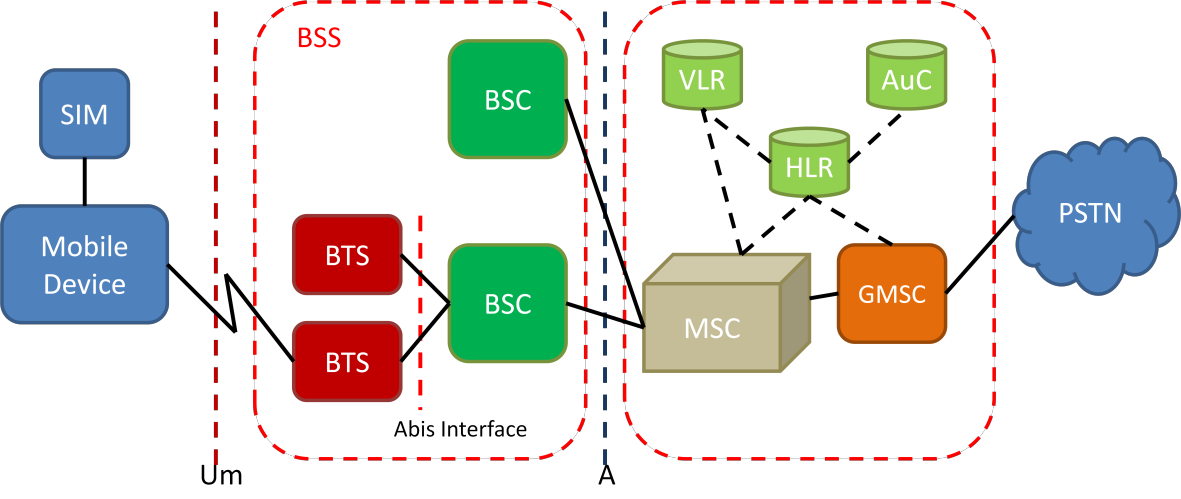1G - First Generation
The first generation of mobile telecommunication is also known by the acronym 1G. This technology came out in the 1980's and by dividing the area to be covered in cells made possible to accommodate a large number of people, since the same frequency could be reused many times. In the 1G system, the voice was modulated in a higher frequency, usually over 150MHz. The use of analog signals for voice transmission led to problems like [1]:
- It's very hard to use advanced encryption methods in analog signal. The lack of security makes possible listening to other people's call or stealing their ID and makes phone calls in their names.
- The quality of the signal is compromised since analog signals are way more susceptible to interference than the digital ones.
- The use of the spectrum is inefficient, since each carrier is dedicated to a single user (active or idle).
2G - Second Generation
To overcome all the deficiencies of 1G network the 2G systems were proposed. 2G systems are completely digital, what solves all the problems created by the use of analog signals. This way is possible to encrypt the signals, to use error detection and correction techniques and to share a carrier among more than one user (using different codes or time slots) [2]. It allows the use of Time Division Multiple Access (TDMA) and Code Division Multiple Access (CDMA). Among the different 2G standards the most important of them is the GSM (Global System for Mobile Communications).
GSM is a European 2G standard. Its commercial development started in 1991, becoming popular worldwide. The first system to be used had an operating frequency of 900MHz, with future variants in 1800MHz, 1900MHz and 450MHz. GSM also supports data connection, with rates up to 9.6kbps. The architecture of a GSM network can be illustrated by the following diagram (Figure 1).
 Figure: 2G Network
SIM: Subscriber Identity Module
BTS: Base Transceiver Station
BSC: Base Station Controller
BSS: Base Station Subsystem
MSC: Mobile Switching Centre
HLR: Home Location Register
VLR: Visitors Location Register
AuC: Authentication Centre
GMSC: Gateway MSC
PSTN: Public Switched Telephone Network
Figure: 2G Network
SIM: Subscriber Identity Module
BTS: Base Transceiver Station
BSC: Base Station Controller
BSS: Base Station Subsystem
MSC: Mobile Switching Centre
HLR: Home Location Register
VLR: Visitors Location Register
AuC: Authentication Centre
GMSC: Gateway MSC
PSTN: Public Switched Telephone Network
 Figure: 2G Network
SIM: Subscriber Identity Module
BTS: Base Transceiver Station
BSC: Base Station Controller
BSS: Base Station Subsystem
MSC: Mobile Switching Centre
HLR: Home Location Register
VLR: Visitors Location Register
AuC: Authentication Centre
GMSC: Gateway MSC
PSTN: Public Switched Telephone Network
Figure: 2G Network
SIM: Subscriber Identity Module
BTS: Base Transceiver Station
BSC: Base Station Controller
BSS: Base Station Subsystem
MSC: Mobile Switching Centre
HLR: Home Location Register
VLR: Visitors Location Register
AuC: Authentication Centre
GMSC: Gateway MSC
PSTN: Public Switched Telephone Network
3G - Third Generation
2G networks could obtain a huge success in the market. The technology was great at supplying the demand for voice communication services. With the increase in popularity of multimedia and internet services 2G systems couldn't provide a satisfactory bitrates. It is solve this issue that the 3G systems come into scene. They would provide 144kbps (full mobility applications in all cases) up to 2Mbps (low mobility applications in the micro and pico cellular environments). Its communication spectrum is between 400MHz and 3GHz [3].
3G systems support symmetric and asymmetric traffic, packet-switched and circuit-switched services, global roaming, among other features.